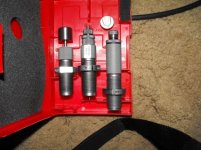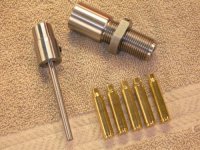I am ignorant of this concept, went to the Hornady site, no info.
How does this work??.........jackie
Jackie,
See
http://accurateshooter.com/bulletin.html. Scroll down to March 22, 2009 "Tech Tip" to see pictures. The text of the article is pasted below.
March 22, 2009
TECH TIP: Form Improved Cases with Hydraulic Forming Die
Filed under: New Product, Reloading — Tags: Form Die, Hydraulic, Improved — Editor @ 10 am
We know many of our readers shoot the 6 BRX, 6 Dasher, 6mm Rem AI, .243 Ackley and other “improved cartridges” that require case-forming. These wildcat designs move the shoulder forward, or alter the shoulder angle and/or body taper. Traditionally, these cases are fire-formed, i.e. a charge of powder is used to blow the shoulder forward and casewalls out. There are different methods of fire-forming. Some guys use a full load of rifle powder, with bullets seated hard in the lands (setting up a false shoulder helps too). Other shooters successfully fire-form without bullets, using fast pistol powders (and a much-reduced charge). Typically, with this bulletless fire-forming, a filler such as Grits is used, along with some kind of plug or wad to hold the powder in the case.
Fire-forming takes time, and consumes expensive powder, primers, and (typically) bullets. Unless you have a dedicated fire-forming barrel, the fire-forming process can use up a significant amount of your useful barrel life, particularly if you are a varminter needing hundreds of re-formed cases. What if you could form your cases at home, at your reloading bench, without burning powder or wasting barrel life? Well you can…
Hydraulic Case-Forming with Hornady Die
Now, thanks to Hornady, shooters who need to “improve” their cases have a bonafied alternative to fire-forming. Hornady’s custom shop offers a hydraulic case-forming kit that allows you to form cases just using water and a conventional reloading press.
Because fluids, such as water, are not compressible, you can use hydraulic action to change the shape of your brass in a die. As a ram or piston moves the fluid in the die, hydraulic pressure pushes the shoulder and case walls out to match the “improved” case profile machined into the Hornady die. What you’ll get is a re-formed case with a near-perfect neck-shoulder junction, but with slightly rounded edges where the case body meets the shoulder. However, the edges of the shoulder will normally sharpen up once you shoot the brass for the first time with a full load.
Tips for Hydraulic Case-Forming
The process works well… as long as you understand that it will take a final fire-forming stage to fully “blow out” the brass. The hydraulic process gets you 95% of the way there. Lonnie Hummel, technician of Hornady’s Custom Shop, uses a hydraulic forming die himself to produce his wildcat varmint cases. Lonnie recommends using regular water as the hydraulic fluid, but other shooters have used isopropyl alcohol, and some guys have used light machine oil. The different fluid choices have pros and cons. With water, you have to be careful to dry out the forming die so it doesn’t rust. With oil you have to make sure you remove ALL the oil from the case before firing. That’s very important for safety and to ensure you don’t “kill” your primers. Alcohol seems to work well, but again you want to make sure residues are removed, so that any residual alcohol does not contaminate primers or powder.
Ordering a Hydraulic Forming Die
Hornady hydraulic forming dies are produced on a custom basis. You need to supply a reamer print or some “finished” cases that have been fully fire-formed in your chamber. Then Hornady can build a die that matches your improved or wildcat chamber. Also, after heat-treating, each die is custom-honed so there is a super-close fit with the shaft of the hydraulic piston.
How much will it cost? Prices vary depending on the size of the parent cartridge: for cases up to 2.6″, the cost is $165.00; for cases over 2.6″ up to 2.9″ the price is $185.00. These prices are for the complete Hornady Hydraulic Forming Kit, which includes Die Body, Lock Ring, Hydraulic Piston, and a special shellholder (without a center hole).
For more information contact Lonnie Hummel at Hornady. Call (308) 382-1390 and ask for the Custom Shop or email: lhummel [at] hornady.com. NOTE: You will NOT see this product listed or illustrated on Hornady’s website. Hydraulic form dies are special order items.





